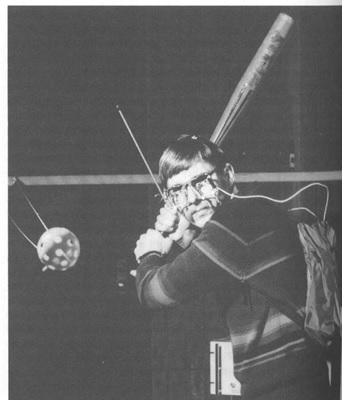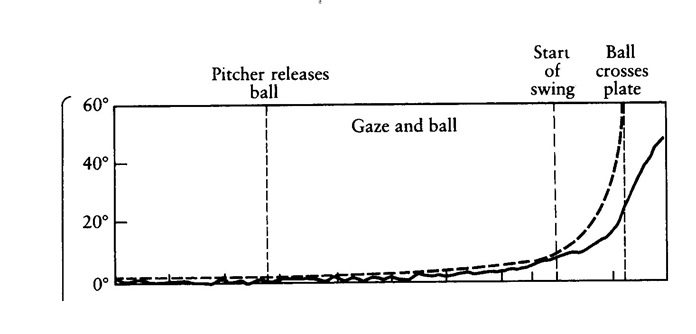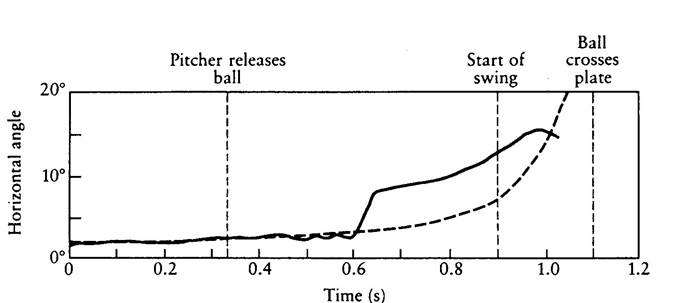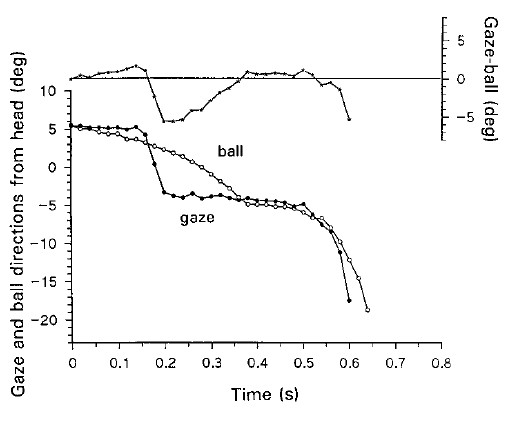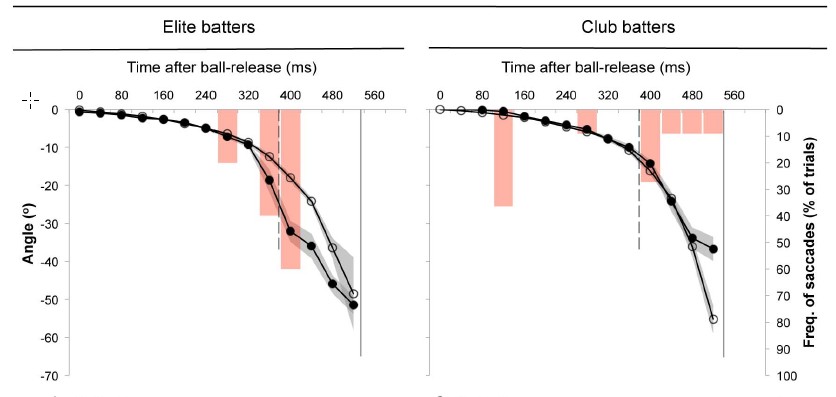[shadowbox]
Eye & Head Movements in Batting: Challenging the “Truths”
Having considered what a batter should do with their eyes before the ball is released in my previous post, I now want to move on to look how a batter tracks the ball from the pitcher’s hand to the plate. In reviewing what we understand about this process I wanted to cover both the “classic” studies in this area and some more recent ones that have challenged long-held truths. I am also going to try to point out some of the limitations of previous research and what I think we need to do moving forward. Finally, although my primary goal is to focus on baseball batting, I am going to bring in relevant data from studies of cricket where appropriate.
The “Classic” Studies
Amazingly, the first study to investigate this issue was in 1954! Hubbard & Seng (1954) visually inspected 35-mm films of professional batters to determine at what intervals during the ball’s flight gross eye and head movements occurred. The major finding was that the hitters’ smooth pursuit eye movements do not continue until the point of contact: No movements were observed within roughly 150–200 ms prior to contact. Or put another way, eye movements stopped when the ball was about 8-15 feet from the plate. On the surface, this finding is not surprising given that major league pitches can travel at rates up to 1,000 deg/sec, whereas the fastest pursuit eye movements recorded in humans are only about 90 deg/sec (Watts & Bahill, 1990). Hubbard and Seng also somewhat surprisingly found that batters do not seem to reduce this large discrepancy by moving their heads with the flight of the ball. They hypothesized that the batters “gave up” only following the last part of the ball’s flight because it was too late to adjust the swing so any additional visual information collected would be of little use. Although the analysis methods available at the time of this now 63 year old study were quite crude, it remains one of the only studies to investigate eye movements in baseball under highly realistic conditions. As we will see, until very recently there have been major trade-offs between accurate measurement and ecological validity.
The next major study of eye movements in baseball batting would not occur for another 30 years: Bahill & LaRitz (1984). This study compared movements made by former MLB player Brian Harper with a set of less-skilled batters (a mix of college and recreational players). Although this study represented a major improvement in terms of the eye tracking methodology (an infrared limbal tracker was combined with LEDs mounted on the batter’s head) it was actually a major step backwards in terms of realism. Batter’s viewed (and did not actually try to hit) a wiffle ball that was moved towards them via a pulley system as shown in the figure below. As a result of this apparatus, the ball did not have the normal vertical movement that occurs with real pitches and the equivalent pitch velocity was only about 40 mph.
The main finding (shown in the figure below) confirmed the observations of Hubbard and Seng (1954): Even a major league hitter cannot follow a pitch with their eyes all the way from release until contact. Harper’s eye movements (solid line in figure below) could track the ball’s movement (shown with dashed line) very well until the ball was roughly 5.5 ft from the plate, at which point it was no longer in foveal vision. Harper generated smooth pursuit eye movements that reached speeds of up to 120 deg/sec which were higher than had ever been reported in the eye movement literature. As might be expected, the less skilled hitters lost foveation of the ball considerably earlier, when it was an average of 9 ft from the plate. Harper also used a superior strategy for following the ball: He used a combination of head and eye movements in equal balance, whereas amateurs tended to predominately move one or the other. Using a combination of eye and head movements increases the effective gaze velocity above what can be achieved with eye movements alone. Also noted by Bahill & LaRitz, was that Harper was successfully able to inhibit the vesitbular ocular reflex (VOR) which is the generation of an eye movement equal and opposite to that of a head movement.
Interestingly, Bahill & LaRitz found that some of the batters in their study appeared to use a completely different eye movement strategy. As shown in the figure below, this involved following the ball with eye movements for the first part of its flight (until it was roughly 25 ft from the plate) and then making a quick saccadic eye movement to a point in space that is predicted to be just ahead of the ball. After the saccade is finished, the ball is foveated and tracked with smooth pursuit eye movements until contact is made. Note that saccadic eye movement are roughly 10x faster than smooth pursuit movements but this comes at a cost: we are essentially blind during a saccade.
Bahill and LaRitz termed the strategy of trying to follow the ball for as long as possible the optimal hitting strategy because it gives the hitter more time to recognize the pitch type and judge its trajectory. The main advantage of the second, jumping eyes ahead strategy is that the batter can evaluate the accuracy of their trajectory judgments e.g., if your eyes are not on the ball after the saccade then your judgment was incorrect. For this reason, it was termed the optimal learning strategy, because it gives the batter the best chance to make adjustments and make technical refinements. Or in other words, it is best suited for improving in the future rather than maximizing present performance.
Although the task dynamics are quite different due to the ball bouncing before the batter must hit it, early research on eye movements in cricket seemed to be consistent with some of the early baseball findings. Specifically, Land & McLeod (2000) found that the expert batters in their study also could not keep their eye on the ball the entire time. Instead, they used a strategy similar to the optimal learning strategy found by Bahill & LaRitz. In the case of cricket, this involved jumping the eyes ahead (using a saccade) to the predicted bounce location. This can be seen in the figure below where the white dot is the batter’s gaze direction and the black dot is the ball.
Represented graphically in the figure below, it can be seen that the batter’s gaze follows the ball for a little bit then diverges from it only to reconnect with it after the bounce. In their study, which included batters of different skill levels hitting a ball thrown by a pitching machine, Land and McLeod also found that the latency of the predictive saccade (i.e. how long it took the batter to generate it) was related to batting performance. In other words, skilled batters initiated the saccade earlier in the ball’s trajectory, presumably because they could predict its trajectory more quickly.
Summary of Results
From this early work there were some key conclusions that were held to be truths in this area for many years:
1)Baseball batters cannot keep their eye on the ball for it’s entire trajectory because the speeds are simply too great
2)Batters do not use visual information late in the ball’s trajectory
3)A baseball swing is a ballistic action. Once a the batter makes the prediction about the future location they initiate the swing and cannot use visual information to adjust it after it begins.
4)In most cases, batters cannot see the ball clearly at the point of bat-ball contact because it will be well out of their foveal vision at that point
5)The only way a batter’s gaze can be aligned with the ball late in the flight trajectory is through the use of a predictive saccade. However, this requires predicting the pitch type and trajectory a very short time after it is released thus increasing the chance of being incorrect. For these reasons, in baseball, using predictive saccades is likely a sub-optimal performance strategy and is better saved for learning/adjustments (e.g., when taking a pitch or in practice).
Limitations & More Recent Research
Mann et al. 2013 investigated eye movements in cricket batting in a study that addressed two of the limitations of the “classic studies” described above. First, instead of attempting to hit a ball moving along a string or one launched by a simple pitching machine, Mann et al used a pitching simulator. Specifically, participants batted against a ProBatter ball-projection machine
which displayed life-size video projected footage of a bowler in their approach towards the batter, and at the moment of ball-release, a ball was projected through a hole in the screen. Adding the pitcher/bowler is important because, as I discussed in my previous post, this is likely to effect how prepared the batter is to track the ball after release. The second limitation they addressed relates to the skill of the batter. It has been argued that none of the previous studies described above used what we might consider to be truly elite batters (e.g., Brian Harper has a career batting average of OPS+ of 103 where league average is 100). Mann et al.’s study included Justin Langer a multiple record-holding, international-level cricket batsman from Australia.
The first thing they found when testing Langer was that his subjective impressions of batting did not agree with some of the “truths” listed above. In particular, he described being able to clearly see the markings on the ball when it struck his bat. Baseball fans will know that Ted Williams also made similar claims. In the eye tracking part of the study, two elite batsmen (one being Langer) were compared to two club-level players. The pitch speed was 75 mph. The basic effects found can be seen in the figure below where the batter’s gaze is shown with black circles and the movement of the ball is shown in white:
If we first consider the figure on the right for the less-skilled club batters, the pattern is similar to that found by Bahill & LaRitz. Before the ball arrives (shown by the solid vertical line) the batter’s gaze diverges and lags behind the ball so it would not be seen clearly at the point of contact. But the story is very different for the Elite players shown in the figure on the left. No only did they not lose the ball before contact but there eyes were actually a bit ahead of the trajectory showing evidence of anticipation. There is absolutely no indication that the movement was too fast to keep the eye on the ball. And, consistent with Langer’s comments, the gaze was exactly aligned with the ball at the point of contact. Or, as the authors put it, the elite batters seems to “park their gaze” and “lie in wait” for the ball to arrive. To achieve this the elite batters appeared to used a very simple strategy: couple the rotation of their head to the movement of the ball and move the eyes slightly in advance of moving the head.
Recently, I invited David Mann and colleagues to submit an article for the 125th anniversary special issue of JEP:HPP that will be coming out later this year. So, I am going to use my editor privilege to tell you a little about their most recent study. Again the authors sought to advance the field by addressing some important limitations of previous research (including their own). One of the major limitations of previous studies is that the pitches have been highly predictable in terms of both movement and speed. In baseball, one of the most important roles of vision in batting is being able to recognize the pitch type (e.g., curveball vs. fastball). With this requirement removed, it is possible that gaze behavior will be completely different. To address this issue, straight pitch trajectories were mixed with curved ones. The other limitation addressed in this study was the small sample sizes used in previous research. In this “in press” study, a total of 43 cricket players from 2 levels and 2 age groups were tested. Without giving away all the findings before the paper is published, here a couple of the most interesting results. First off, the results failed to support the claim that more skilled batters make faster predictions about the future location of the ball and use them to initiate early saccadic eye movements to this location (as was found in Land & McLeod, 2000). Instead, they seemed to wait longer to initiate movement so that more updated ball-flight information can be used. A second important contribution of this study is to highlight the importance of expectations about the ball flight on interception. Specifically, it was shown that the possibility of a curved trajectory led to significant changes in the visual-motor behavior and hitting performance of skilled batters.
Although they didn’t measure eye movements, another study that is relevant to this discussion is Higuchi et al.. 2016. They examined they effect of occluding vision of the ball during its flight on batting performance for 10 college players. The PLATO Occlusion spectacles were used for the study (see my vlog for demo). Two pitch speeds were used but I am going to only look at the results for the fast speed which was 90.7 mph with a total flight time of 0.419 msec. Three occlusion conditions were compared. R+150 – only the first 150 msec of the ball’s flight was visible and then vision was occluded, A-150 – the final 150 msec of the ball’s flight was occluded, and a NO occlusion condition. The figures below show the spread of bat-ball contacts for the three conditions:
A couple different effects can be seen here. First, the spread of contact is significantly larger (with the ball missing the bat in several cases) for the R+150 condition shown on the far left. This suggests that viewing only the first 150 msec of the trajectory results in less accurate bat control so batters must still be able to make use of visual information beyond this point. Second, the difference in swing accuracy between the A-150 and NO occlusion conditions is negligible (and was not different statistically). This suggests that batters do not make use of visual information in the final 150 ms of the ball’s flight to adjust their swing. In terms of distance, this is roughly the last 20 feet of travel to the plate. The authors proposed that information this last 150 ms period is not useful because of the speed of the swing and visuomotor delay (i.e., the time it takes to use visual information to make a movement).
The final paper I want to mention is a very recent one by Fogt & Persson (2017). This pilot study looked at both horizontal and vertical eye movements for 2 college baseball players. Participants watched tennis balls launched by a pitching machine at 75 mph. The main finding was that eye movements were significantly different when batters were asked to “take” (i.e., not swing) at the pitch as opposed to when they tried to hit it. In the “take” condition, head movements were larger than eye movements and batters tended to use the optimal learning strategy – this involved initiating a saccade at roughly 150 ms before the ball reached the plate. In the “swing” condition, head movements were larger than eye movements and the optimal hitting strategy was used. Specifically, the batters kept their gaze on the ball for was long as possible — until it was roughly 50-60 msec from crossing the plate.
Summary & Future Directions
More recent research on batting has challenged some of the long held beliefs in this area. Specifically,
1) There does seem to be some evidence that batters CAN follow the ball with their gaze through most of the trajectory using head rotation matched to the ball’s movement and eye movements that are slightly ahead.
2)Batters do not seem to make predictions about the ball’s trajectory very early in its flight and instead seem to be using visual information up to at least 150-100 ms before contact.
3)Gaze tracking strategies seem to be highly sensitive to context and depend on whether or not the batter is “taking” a pitch or not, whether the trajectory is predictable, and whether or not the pitcher is visible.
4)More research is needed in realistic settings that include a pitcher, a ball with laces, and a mixture of different pitch types.
[/shadowbox]

